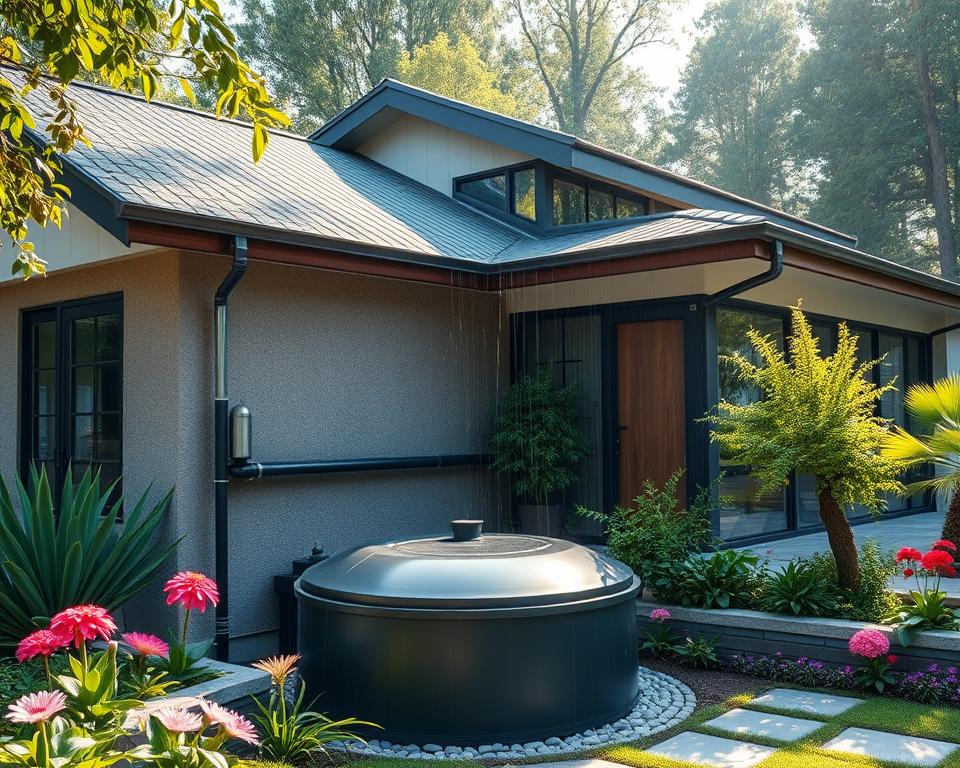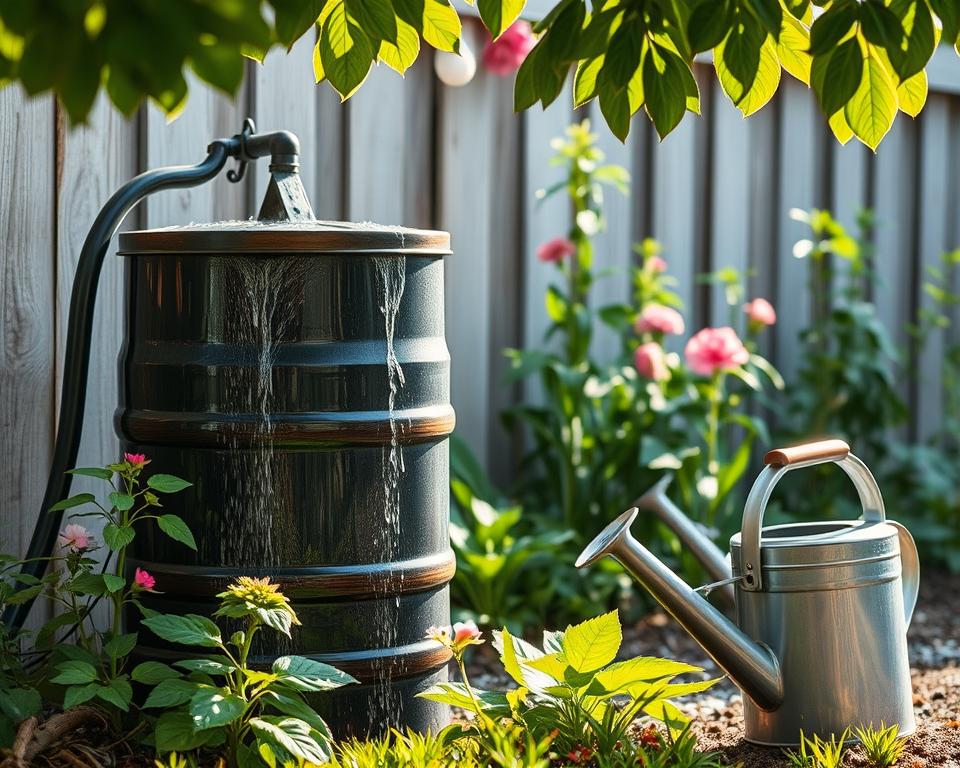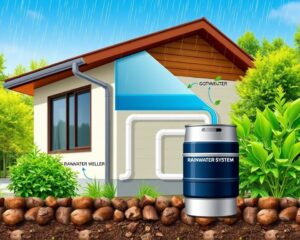Did you know that the average household in the United States can harvest over 10,000 gallons of rainwater each year? This is possible by using their roof space. With rising utility bills and water scarcity, rainwater harvesting is becoming more popular. It’s a smart way to save water and reduce the load on public water systems.
In this guide, we’ll cover the basics of rainwater collection. We’ll debunk myths, help you figure out your water needs, and guide you in choosing the best systems. You’ll learn how to harness this valuable resource and help your community manage water sustainably.
Understanding Rainwater Harvesting
Rainwater harvesting lets people collect and use rainwater for many things. It saves water and cuts down on using city water. You can set up systems that fit your needs, making your home more sustainable.
What is Rainwater Harvesting?
Rainwater harvesting means catching rainwater from roofs or hard surfaces. It uses systems to catch and store water. Rooftop harvesting is common, especially in cities. It uses gutters and downspouts to collect rainwater.
Benefits of Rainwater Harvesting
Rainwater harvesting has many good points for homes and the planet:
- Water Conservation: It cuts down on the need for treated city water, saving money.
- Environmental Responsibility: It helps prevent floods and erosion, keeping ecosystems healthy.
- Cost Savings: There are incentives from local and federal groups that make it cheaper to start.
- High Yield Potential: For example, you can get about 623 gallons of water per inch of rain over 1,000 square feet.
Common Misconceptions
Many people get rainwater harvesting wrong. Some think the water is always unsafe. But, with the right treatment, like filtration and disinfection, it’s safe to use.
Others might think rain barrels are the only choice. But, there are many types of systems, like dry and wet ones, for different needs and spaces.
Assessing Your Water Needs
Before starting a rainwater collection system, it’s key to know how much water you use. This helps plan a system that meets your needs. Knowing how much water your home uses is the first step to successful rainwater harvesting.
Calculating Your Usage
Begin by checking how much water you use every day. On average, people use about 70 gallons of water at home daily. Looking at your water bills can show how much water you use each month.
Outdoor water use changes with the seasons. By comparing your winter and summer bills, you can see how much rainwater can save you.
Identifying Efficient Usage Areas
After figuring out your total water use, look for ways to use less. Using rainwater for things like watering plants or flushing toilets cuts down on city water use. This is good for the planet and your pocket.
Teaching others about saving water can also help. It makes your community better at saving water and using rainwater.
Choosing a Rainwater Harvesting System
Starting rainwater harvesting means understanding the different systems available. Each type fits specific needs and spaces. Choosing wisely can save water and help the environment.
Types of Systems Available
There are many rainwater harvesting systems. The most common is rooftop collection, especially in cities. Other systems include:
- Surface runoff harvesting: This method collects rainwater from surfaces and stores it in tanks.
- Rainwater harvesting detention methods: These systems let rainwater soak into the ground, recharging aquifers.
Factors to Consider While Choosing
When picking a rainwater harvesting system, consider a few key factors. These can greatly affect your choice. Think about:
| Factor | Description |
|---|---|
| Space Availability | Check if you have enough space for tanks and collection systems, like rooftops or open areas. |
| Water Needs Assessment | Figure out how much water your household uses daily. The average is about 70 gallons. |
| Cost | Look at your budget for setup and upkeep. Prices vary by size and complexity. |
| Water Quality | Think about how to filter water for safe use, especially for drinking. |
| Local Regulations | Check local rules and permits needed for rainwater harvesting. |
By looking at the different systems and these important factors, you can choose wisely. This choice will make your home more sustainable and cut down on water costs.
Planning Your Rainwater Collection System
Planning a rainwater collection system needs careful thought. You must pick the right ideal locations and know the key rainwater harvesting components for success.
Ideal Locations for Collection
Choose spots that get the most rainwater runoff for best results. These are usually:
- Directly below downspouts from your roof
- Flat surfaces like patios or driveways
- Areas with natural slopes to guide water to storage
Rooftop collection is very common, especially in cities. It can catch a lot of rainwater. For example, a 1,000 square foot roof can collect about 623 gallons per inch of rain.
Essential Components of the System
An effective system needs different parts that work well together. Key components include:
| Component | Description |
|---|---|
| Catchment Area | The surface that collects rain, mainly rooftops. |
| Conveyance Systems | Pipes and gutters that move rainwater to storage. |
| Storage Vessels | Containers that hold the rainwater; sizes range from small barrels to large tanks. |
| Treatment | Filtration systems to make the water safe for use. |
| Distribution Mechanisms | Systems that bring treated rainwater where it’s needed, like irrigation or indoor plumbing. |
Knowing these rainwater harvesting components and where to place them can boost your system’s performance.
Determining Legal Requirements and Permits
Before starting with rainwater harvesting, it’s key to know the legal rules in your area. Knowing local laws and building codes helps you set up a system that works well and follows the law.
Checking Local Regulations
States have different rules for rainwater harvesting. Check your local rules to see if harvesting is allowed. Knowing these rules can help avoid fines and changes after you’ve set it up. Some states limit how big your rainwater tank can be.
It’s smart to talk to local water authorities or agencies. They can tell you exactly what rules apply in your area.
Understanding Building Codes
It’s also important to know the building codes. These codes say what materials and methods you can use for your system. Following these codes makes your system safe and helps during inspections and when getting permits.
Looking into your state’s plumbing codes can also help. You’ll learn about things like filtration and preventing backflow.
| State | Regulation Level | Storage Limitations |
|---|---|---|
| California | Encouraged | None |
| Florida | Supported | Approved size required |
| Colorado | Very Limited | Strict restrictions apply |
| Texas | Encouraged | None |
| New Mexico | Supported | Approved size required |
| Wyoming | Strict Restrictions | Strict limitations apply |
Knowing these things helps you make good choices for your rainwater system. With the right knowledge, you can create a system that’s good for you and the planet.
Designing Your Rainwater Storage
Creating a good rainwater storage system needs careful planning. You must think about the types of storage tanks that fit your property and needs. Each type has its own benefits, so picking the right one is key.
Types of Storage Tanks
There are many types of rainwater storage tanks:
- Above-Ground Tanks: These tanks are simple to install and easy to maintain. They come in many sizes and materials, making them a favorite among homeowners.
- Underground Cisterns: These tanks save space and can look good in your yard. They keep the water cool and save it from evaporation but need more work to install and keep up.
- Rain Barrels: Great for small homes or gardens, rain barrels catch water right from your roof. They’re cheaper and easy to put up, perfect for beginners.

Choosing the Right Size for Your Needs
Picking the right size for your rainwater tank is very important. You should think about:
- Roof Area: The size of your roof affects how much rainwater you can collect. About 623 gallons can be collected from a 1-inch rainfall on a 1,000 square foot roof.
- Water Usage: The average U.S. home uses 25 to 100 gallons of water each day per person. Think about how much water your home uses daily and seasonally to figure out the right tank size.
- Rainfall Patterns: How much rain your area gets each month and year affects how much water you can collect. Places with more rain need bigger storage solutions.
A well-designed rainwater harvesting system can save a lot of water. It lets you use rainwater all year, making your water supply sustainable. By picking the right rainwater tank size, you can make sure your system meets your home’s needs.
Installing Your Rainwater Harvesting System
Installing a rainwater harvesting system is rewarding and good for the planet. It helps your home and the environment while saving water. Planning well and doing it right is crucial for success.
Tools and Equipment Needed
First, get all the tools you need for installation. This makes setting up your system easy and effective. You’ll need:
- Hacksaw
- Level
- Screws
- Rain barrels or tanks
- Downspouts
- Connector hoses
Having the right tools makes installing your system easier. It also helps it last longer.
Step-by-Step Installation Guide
Setting up your rainwater system is simple. Just follow these steps:
- Check local regulations to make sure you can install a rain catchment system.
- Pick a good spot for your rain barrel or tank. It should be stable and level.
- Put up gutters and downspouts to guide rainwater to your system.
- Connect your rain barrels or tanks to the downspouts with hoses.
- Check everything for leaks and make sure it’s all secure.
- Think about how you’ll treat and use the rainwater, depending on what you need it for.
Cleaning and checking your gutters often will make your system work better. These steps help you use water wisely.
| Component | Description | Capacity |
|---|---|---|
| Simple catchment system | Basic setup for collecting rainwater | 40 to 100 gallons |
| Complex system | Larger systems with extensive collection capabilities | Up to 5,000 gallons |
| Rain barrels | Opaque containers to store harvested rainwater | Varies, typically around 50 to 100 gallons |
| Gutters | Conduits to channel rainwater | N/A |
Knowing about these parts will make your rainwater system better. Your effort helps save water and supports a green community.
Maintenance Tips for Your System
Keeping your rainwater harvesting system in top shape is key to getting the most out of it. Regular upkeep stops problems before they start and makes your system last longer. A good maintenance plan can help avoid future headaches. Here are some ways to keep your rainwater system running smoothly.
Regular Maintenance Tasks
- Keep gutters clean: Regularly remove debris to ensure proper water flow.
- Inspect filters: Check filters frequently for clogs that can impede efficiency.
- Clean screen baskets: Regular cleaning prevents contaminants from entering the system.
- Maintain the storage tank: A yearly cleaning of your rainwater tank is advisable to remove sediment and organic matter.
- Service UV bulbs: Change UV bulbs as per the manufacturer’s recommendations to ensure effective disinfection.
- Chlorinate plumbing lines: Disinfecting lines periodically can help maintain water quality.
- Regular water testing: Conduct tests to check for pH levels and contaminants, ensuring safe usage.
- Log maintenance activities: Keeping a maintenance log can help track tasks and schedule future actions effectively.
Troubleshooting Common Issues
Even with careful maintenance, problems can still pop up. Common issues include:
- Reduced water flow: This may indicate filter clogs or tank sediment buildup.
- Unpleasant odor: This could signal algae growth or contamination within the system.
- Leaking storage tanks: Regular visuals checks can catch leaks before they escalate.
By sticking to these maintenance tips, you can handle and fix problems with your rainwater harvesting systems. This ensures a steady and clean water supply for your needs.
Using Collected Rainwater
Embracing rainwater harvesting is a great step towards sustainable living. It lets you use this valuable resource wisely. You can save water, cut down on costs, and help the environment.
Safe Ways to Use Harvested Water
Using collected rainwater is more than just watering plants. You can also:
- Irrigate gardens and landscapes
- Flush toilets to save on municipal water
- Wash vehicles or outdoor spaces
- Water livestock and wildlife
With the right filters and treatments, rainwater can even be safe for drinking, cooking, and bathing. Using rainwater in these ways helps support conservation efforts.
Integrating with Your Home Water System
Adding rainwater to your home’s water system makes it more efficient. By linking rainwater systems to your home’s fixtures, you get:
| Integration Type | Description | Benefits |
|---|---|---|
| Non-Potable Uses | Connect harvested rainwater to toilets and laundry systems. | Reduces demand on municipal systems and cuts costs. |
| Potable Applications | Install advanced filtration systems for safe drinking water. | Provides an alternative water source, especially in emergencies. |
| Outdoor Systems | Use collected rainwater for irrigation and landscape maintenance. | Aids in water conservation and supports local ecosystems. |
These practices help you live more environmentally friendly while managing water better. By using rainwater, you contribute to sustainable living.

Inspiring Examples of Successful Systems
Looking at successful rainwater harvesting systems can teach us a lot about living sustainably at home. People all over the world have set up creative ways to collect rainwater. This has led to big savings on water bills and a smaller impact on the environment.
These stories show how practical and creative rainwater harvesting can be. They inspire us to find our own solutions for different homes and places.
Case Studies from Homeowners
In Austin, TX, “The Independent” is a standout. It has a top-notch rainwater and solar power system. This makes it a true example of sustainability.
In Las Vegas, NV, “Fort 137” uses a modern system to save water in the desert. And in Mexico, “Rain Harvest Home” meets all its water needs with a smart setup. These examples show how effective rainwater harvesting can be.
Sustainable Practices to Emulate
These examples show the big water savings and sustainability gains from rainwater harvesting. The Tucson Mountain Retreat in Arizona has a 30,000-gallon system for all its needs. This shows how important it is to use such effective solutions.
As you think about starting your own rainwater harvesting, remember these lessons. Use these homeowner experiences to find ways to live more sustainably. This will help make our environment healthier for everyone.




